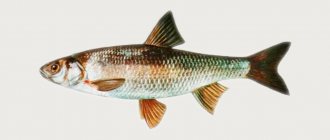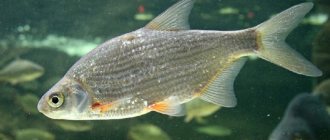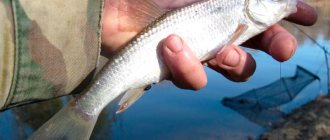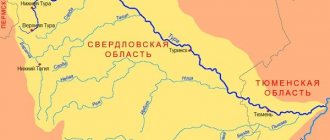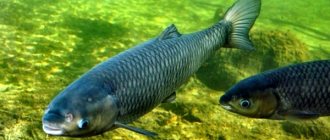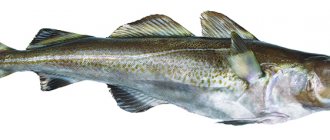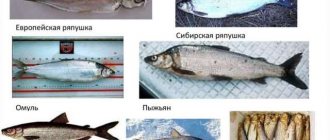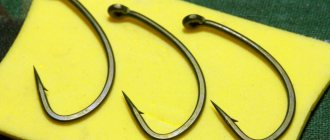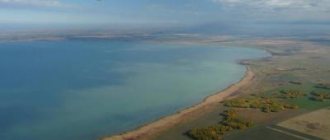- Wild animals
- >>
- Fish
The dace is quite modest in size, but has extraordinary agility and mobility, so only an experienced fisherman can catch it. The excitement of fishing is serious, because here you need to show all your dexterity and agility. Let's try to figure out what kind of underwater life the dace leads, how it stands out among other fish, what it prefers for lunch, where it is constantly stationed and how it spawns?
Origin of the species and description
Photo: Yelets
The dace is a ray-finned fish and belongs to the family Cyprinidae, the order Cypriniformes and the genus Dace.
The most common is the common dace, but there are two more subspecies of this fish:
- the Kyrgyz dace has chosen the waters of Kyrgyzstan and Kazakhstan;
- Siberian dace inhabited Siberian rivers.
There are also subspecies of fish belonging to the genus dace, among them are:
- Zeravshan dace;
- Transcaspian dace;
- Danilevsky dace;
- Talas dace.
Common characteristic features are common to all subspecies, but there are also specific differences. The Danilevsky dace has a dark gray or black ridge, and the scales on the sides are silver-gray. The fins located below are yellow-orange or yellow-red in color. The iris of the eye has a yellow-orange tint.
Video: Yelets
The Siberian dace has a dark green back and silvery sides. The color of the fins may be slightly reddish or completely whitish. The body shape of this fish is higher than that of an ordinary dace, the appearance of which we will describe in detail below. The Siberian is also distinguished by its terminal mouth.
It is worth noting that the appearance of dace and their dimensions are largely determined by the places of their permanent location and the presence of food supply in the reservoir. These fish are not distinguished by their large size and large shape. On average, the body length of a dace is about 15 cm.
Interesting fact: There is recorded data that the length of the largest dace caught was 40 cm, and its weight was equal to one kilogram.
Description of dace
Dace belongs to the ray-finned fish of the widespread carp family. This silvery fish is often the very first one that meets an angler on small rivers after winter freeze-up and rising flood waters. And dace is often the only prey in this early spring, when other fish are not biting. As soon as forest rivers begin to enter the banks, many fishermen are already getting ready to go fishing. But this time is a fishing season conditionally. And the prey, most likely, can only be a nocturnal predator - burbot . The water temperature is still low, almost winter, and for most inhabitants of the underwater world it is not comfortable. Therefore, it turns out that the daytime prey is dace, and often large ones, and at night it takes burbot on the bottoms. Apparently, the dace has somehow adapted to the low water temperature and fast spring flow. Later, these fish often stay in pools with reverse currents and switch to a summer diet.
Appearance and features
Photo: What a dace looks like
Dace is a freshwater fish that prefers rivers with clean water, rich in oxygen and a rocky bottom. As already mentioned, the most common sizes of fish range from 15 to 20 cm, and their weight rarely exceeds two hundred grams. The body of the dace is elongated and compressed from the sides, the overall predominant tone of the scales is silver. A darker bluish tint is noticeable on the back, and in the area of the sides and belly the color of the fish is light.
The dorsal fin is truncated and the caudal fin is elongated, they are colored in dark colors, and the fins located in front, as well as the anal rear fin, have a gray tint with a reddish-yellow coating. There are no spots, stripes or other patterns in the color of the dace; a monochromatic silver color scheme predominates, only the ridge is darker in color.
Interesting fact: The color scheme of the fins changes depending on the age of the fish; it acquires a more yellow tone. During the spawning period, the male's anal fin turns deep red.
The head of the dace, relative to the size of its body, is proportional and slightly narrowed. The fish is distinguished by a small semi-lower mouth, in which a two-row arrangement of pharyngeal teeth is observed. The number of gill rakers in dace varies from 8 to 10 pieces. The fish has medium-sized scales; along the lateral line there can be from 45 to 55.
The iris of the common dace is black. The appearance of the dace is similar to the characteristic features of the chub, but the former is distinguished by a narrower body and head. There is also a characteristic notch on the anal gray-yellow fin of the dace, while in the chub it has a semicircular shape and a red color.
What does a dace look like?
In appearance, a large dace is to some extent similar to a chub, only the body of the dace is flatter, slightly compressed on the sides. The chub is more coarse. In addition, unlike the chub, the dace has a narrower head and a small mouth, while the mouth of the chub, which is a real predator, can safely be called a mouth. The anal fins are also different. The chub sports a bright red rounded fin, while the dace has a more modest fin: gray-yellow with a cutout inward. The chub, as already mentioned, has a rounded anal fin (read the description of the chub).
The dace is distinguished by a bluish-gray back, a white belly and silvery sides, a semi-lower mouth and a rather long caudal fin equipped with a notch. The scales of dace, unlike its relative bleak, are quite strong and medium in size. It does not come off under the pressure of your fingers, like bleak, which can be peeled off with just your fingers. But dace also has an external resemblance to bleak. Sometimes these fish, especially small ones, are even confused.
Where does the dace live?
Photo: Yelets in Russia
Dace likes small rivers, where the current is not so fast and the water is clean and transparent. You can also meet this fish in the waters of flowing lakes, in some floodplain reservoirs, which it sometimes visits. Dace love rocky or sandy bottom surfaces. Where the bottom is muddy, you will not see this nimble fish. On the territory of our country, dace inhabits river systems and lakes of the Baltic and other southern seas. The fish has chosen the Siberian and Far Eastern waters.
Thus, Siberian dace can be found in tributaries:
- Kolyma;
- Yenisei;
- Obi;
- Lena.
This species of dace chooses small rivers, gathering in them in numerous schools, which often displace other fish inhabitants. Dace do not live in river systems belonging to the Pacific basin.
Let's consider the distribution area of dace, relative to its other subspecies:
- The Kyrgyz dace has chosen such rivers as the Nura, Chu, and Turgai. The fish lives in the waters of Kazakhstan and Kyrgyzstan;
- Danilevsky dace can be found on the Don and Dnieper;
- Talas dace lives in the lower reaches of Talas, in the Ass River, in lakes Ashi-Kul and Bayli-Kul;
- the Zeravshan dace inhabited the Amu Darya, Zeravshan and Syr Darya;
- Trans-Caspian dace is caught in the waters of the Tedzhen and Murghab rivers.
In the territories of Belarus and Ukraine, dace inhabits:
- Western Dvina;
- Desna;
- Dnieper;
- Northern Donets.
In the western part of Europe, dace lives in lake and river systems of the Baltic, Black Sea and North Sea basins. You will not find it in the areas of the Balkan and Iberian Peninsulas. This fish is considered sedentary, but much depends on the quality and purity of the water. If this indicator changes for the worse, flocks of dace swim upstream, looking for clearer water.
Interesting fact: Dace loves seething riffles, because... in such places the water has a high oxygen content.
Now you know where dace is found. Let's see what he eats.
What does dace eat?
Photo: Dace in the water
The dace menu is quite varied; it includes dishes of both animal and plant origin. The latter are much smaller, but they are still present. Having a semi-lower mouth, the dace needs to swim tangentially, relative to the water surface, in order to quickly and deftly capture food.
The dace is very nimble and swift, so it is able to instantly pounce on anything edible that falls into the water. When dace feeds on the surface of the water, a small splash is heard, created by the fish's body when jumping.
In the summer, the fish diet consists mainly of all kinds of insects that live in the coastal zone (in tree crowns, bushes and grass near the water) and fall into the water. The dace also happily eats aquatic insects and their larvae.
So, fish like to snack:
- dragonflies;
- various beetles;
- butterflies;
- grasshoppers;
- flies;
- midges;
- bloodworm;
- mosquitoes;
- mayflies;
- Shitikami;
- caddis flies.
In winter, the menu mainly consists of:
- plankton;
- crustaceans;
- larvae;
- worms;
- rotifers;
- Daphnia, etc.
In the spring season, during high water, dace graze in floodplain meadows, where they also feast on worms, all kinds of bugs and larvae. As for plant foods, dace prefers to dine on filamentous algae, loves all kinds of cereals (oats, rye, wheat), and loves corn. All this can be judged by the contents of the stomachs of those fish that were caught.
Interesting fact: When the spawning period ends, dace begin to eat off, actively eating the eggs of other fish, causing them great harm.
If we talk about fishing, the tastes of dace change depending on the season. In spring, he likes worms, at the very beginning of summer he likes to eat caddisflies, and at the end of summer he prefers grasshoppers. Anglers should take note of this. Due to its selectivity to various baits, dace is considered a difficult catch; to catch it you need to try hard and study its habits.
Leonid Pavlovich Sabaneev
Rice. 67. Midge (Phryganea) and its larvae
Like other small fish, dace spawns for two years, when its size is at least 3 inches (from the end of the nose to the end of the tail). Spawning always takes place in numerous flocks, in a very noisy manner[2]. There are apparently half as many males as females. The caviar is whitish in color, small, but not particularly numerous, so that the significant prevalence of dace can only be explained by the limited fishing and the extreme agility of this fish, which the French call dard. The juveniles hatch probably after 10 days; already in the first days of May (in the middle provinces) it appears in large numbers near the shores, first in calm waters and even in backwaters, but at the end of June, having reached a length of about an inch, all these small fry go to the water, mostly to the riffles. In August, usually at the end, the fry are already in fairly deep places. At least that’s what I observed on the Moscow River. The food of spruce trees, like almost all fry, here at the end of spring and summer consists almost exclusively of greenery, i.e. mulberry, and pusher mosquito; later, from September, from its larvae, i.e. bloodworms. As for small crustaceans, they have almost no importance in flowing water for young fish due to their small numbers. This is exclusively pond food, not river food, the role of which is still greatly exaggerated by fish farmers and ichthyologists. In late autumn, at the end of October and at the beginning of November, fingerlings, with plenty of food, reach a size of 2, even 2½ inches, as, for example, in 1890 on the Moscow River.
The dace grows very quickly, especially at first, and reaches full age at five or six years. Older specimens, weighing over half a pound, are rare and are not found in all rivers. According to my observations, a one-year-old dace is no more than 2½ inches long (in winter, with rare exceptions, the fish almost does not grow at all); two-year-olds - at least 3 and up to 3½ inches, three-year-olds - 4-4½ inches. A four-year-old dace is at least 5½ inches long and can weigh up to half a pound. Approximately the weight of this fish doubles annually: yearlings - 1/16, 2-yearlings - 1/8, 3-yearlings - ¼ and 4-yearlings - 1½ pounds.
Dace are gregarious and sociable fish. They are always found in large flocks, especially one- and two-year-olds; the largest, however, lead a rather solitary lifestyle and, apparently, prefer backwaters and muddy bottoms. The dace become completely sedentary, that is, they are established in places when the water finally recedes (in small rivers) and the dams are closed. In small dammed rivers with a slight fall, dace stay mainly near mill whirlpools and generally avoid the dam itself. Here, by the way, I note that the reason for the abundance of fish in such pools depends not so much on the influx of fresh water that the fish need in the summer heat, but on the abundance of food. In addition to small fish brought from above by the current in the form of insects, a mass of fingerlings gather in the pool, attracted by bran falling into the water and especially small particles of flour, the so-called. beads, which undoubtedly serve as the main summer and partly spring food for these fry. In general, I am positively convinced that plant food is much more important for fish, especially small fish, than is usually attributed to it. Many times I had the opportunity to observe on the pier how numerous flocks of fry, from sheresperts to bleaks, plucked mulberry, the same greenery with which the underwater parts of boats are densely overgrown, especially those that have been standing for a long time without use. The only thing I didn’t notice during this activity were minnows, ruffes and perches, reptiles on the bottom and not rising to the surface; but even these fish at a young age often stay in that green, mushy mud, which is, in essence, the same filamentous algae (Cladophora and Spyrogyra), only growing in a quiet place and therefore bunching up into large, shapeless clumps.
The sedentary life of flocks of dace is expressed in the fact that they stick to a certain area, going out to the nearest rift in the morning, and in the evening going down to the pits or to the shore. Usually the dace stands one or two inches from the bottom; At half-water, like a roach, it rarely swims, but more often than not it melts, staying close to the surface. Most often this swimming occurs (in summer) on nights, especially moonlit nights, after sunset and before sunrise, i.e. precisely at the time when pusher mosquitoes, midges and broomsticks fly out of the water and fall on it. In small rivers with trees and bushes along the banks, dace also melt during the day, especially in windy weather, when most insects fall. It is very possible that in such places they stick to the upper layers of water throughout the summer. Dace, like bleak, always melts with splashes, probably not without a purpose, since this causes midges and husks flying over the water itself to fall into it.
The sedentary life of the dace is disrupted only by floods after heavy rains. He cannot stand the mud and immediately begins to walk upward until he meets a river, in which he takes refuge for a while. It is difficult to imagine how many dace and other small, or rather young, fish enter the small tributaries of the Moscow River, which are cleared of turbidity when the water in the river begins to become cloudy. The peasants of the Moscow region know this move very well, and after each flood, in each river, dozens of pounds of “smelt” are caught with small-mesh nets, baskets and linen stubs, which are then either sold for two kopecks per bucket, or dried. Dace also cannot tolerate foreign toxic impurities and, in general, when the water spoils due to heat, it soon becomes sick, although in this respect it is somewhat stronger than gudgeon and podust. On locked rivers, like the Moscow River, the flood attracts dace to the dam, sometimes standing ten or more miles below. Some of these aliens remain here, while others soon roll back.
With the onset of cold weather and morning performances, flocks of dace go out to shallow places and rifts less and less often and stay more at a depth of about 3-4 arshins. During frost and after it, not a single fish is stranded, which requires no explanation. Nevertheless, dace feed, that is, they take bait, even melt (in warm weather), until the river freezes.
On the first ice they are still quite lively, they stay near its surface, in the upper layers, but soon they lie down in the deepest holes, almost inaccessible to the seine. From here they come aground only during prolonged thaws.
In industrial terms, dace is sometimes even inferior to bleak. It is rarely caught in seines and other nets, and is caught mainly in the tops during spawning. The value of these fish is very insignificant, and they have only local sales. Not so long ago (it seems about ten years ago) in the Moscow River, which is distinguished by an abundance of dace, they began to be caught with seines and fishing rods in large quantities for smoking, and smoked dace under the name “Moscow vendace” acquired a large number of consumers. Although it is far inferior to real vendace and is rarely well smoked, it is quite tasty and, most importantly, cheap - about 30 kopecks. ten. For a pound of smooth dace, at least 2 years old, smokers pay 4 rubles.
I won’t go into much detail about the fishing of dace - not, however, because this fishing does not represent anything particularly attractive for anyone, but because all the methods of catching this fish differ little from those already described above. Despite the insignificant size of the dace, the latter has many fans, of course, mostly in places where there are few large fish. Among the Moskvoretsky fishermen, one can count more than a dozen masters of fishing for dace, who have achieved almost virtuosity in this and catch almost pounds of it where others cannot catch even several dozen of this nimble fish. The fact is that fishing for dace requires great agility and considerable skill, and you almost exclusively have to catch it in the current, constantly rethrowing the fishing rod, constantly ready to hook. Such active fishing has many advantages over passively waiting for a bite during ordinary fishing with a float in ponds and calm waters, as well as using bottom retrieval in the current.
The relationship between active methods of fly fishing, retrieving, etc., and the latter methods is exactly the same as between shooting at a fly and shooting at a stationary game. For a real hunter, not a skinner, it is much more pleasant to kill a snipe at an age than, for example, a black grouse on a lek. The dace, perhaps, can be called a water snipe, and if it is full, then catching it is quite difficult. Pond fishermen, accustomed to the sluggish bite of pond fish, even bottom lovers - “blind” fishermen - when fishing for dace, and in any fishing with immediate hooking, always suffer a shameful fiasco, and precisely because they are accustomed to taking their time, as they are not accustomed hurry up arrows on sedentary game. I personally am of the opinion that catching dace is much more fun than ruffs, small perches, minnows and even roaches, although they are much larger.
For fishing dace, the lightest and thinnest tackle is usually used. The fishing rod is flexible, light, from 3 to 5 arshins long, if possible - solid, preferably reed; line of 3, even 2 selected hairs, sedge float, made of porcupine or feather quill, hook from 10 to 12 no. Fishing for dace on English rods with a reel is an unnecessary luxury: catching small things with a machine, if not completely ridiculous, is quite funny. Although dace can be fished using almost all known methods, the main one is still the baiting described below (see “Ide”). Without a float, you should not specifically catch dace with a fly, just as you should not fish for it with a self-loading float (see “Chub”) and with a cork (see “Ide”), except in very rare cases. Then, without a lot of bait you won’t be able to catch him, although on the rifts you can sometimes do without it. Of course, no one does any preliminary baiting for dace and the bait is only thrown during fishing. It varies depending on the season, but is almost always mixed with clay. In my opinion, it is much better to replace clay with cottage cheese mixed with dough and large bran, in varying proportions, depending on the strength of the current; Bloodworms, ant eggs, maggots, and steamed grains are added to this mass. This bait attracts dace very quickly, and from very long distances. They lower it either in perforated tins, or in a fine net with a heavy load near a boat, which this fish is almost not afraid of, unless the depth exceeds an arshin or one and a half (in clear water). With such bait, several times in July 1891 I managed to catch more than a pound and twice up to one and a half pounds of fairly small dace. And in total, in the darkest time for fishing, I caught about 18 pounds of this fish. In general, metropolitan fishermen, according to rough estimates, annually catch from 200 to 300 pounds of dace, and this is only in urban waters. There is nothing surprising here if we take into account, firstly, that fishing with any gear other than a fishing rod is prohibited here, and secondly, the unusually rapid growth of the local fish, due to the abundance of food.
Fishing for dace with a fishing float begins in the Moscow River as soon as the water clears, b. hours in the second half of April, but sometimes in the first (in 1890 from April 10). At first they catch it with bloodworms, with the same complementary food, in places that are not particularly fast, but then, as the water decreases, they are fed more and more into the water. I mean, of course, fishing from a boat, since it is incomparably more correct and convenient than fishing from the shore. In May, when the bloodworms begin to fly out, large ant eggs serve as bait. By the way, I note that in Pskov dace are also caught using these so-called. “pies”, with 2-4 arshin spruce rods with an extended juniper tip. In general, these ant pupae should be recognized as the most convenient and easily accessible bait for small and medium-sized fish. In summer, dace takes very well on maggots, which surpass all other baits in their durability. Aged maggot (especially in cheese) becomes like gutta-percha, and
Features of character and lifestyle
Photo: Dace fish
Based on its fish diet, dace can easily be classified as a predator, and therefore it behaves accordingly: it waits in the stream of water, hiding behind various stones, bottom mounds, and snags. The fish instantly attacks insects swimming past or falling into the water. The dace also likes to hunt insects that fly low, almost at the very surface of the water. The fish, catching them, jumps out slightly, creating a small splash on the water surface.
Interesting fact: Dace can be called a schooling fish. Especially young fish, two- and three-year-old individuals live collectively, only older fish can live alone or in groups containing from 2 to 5 dace.
In the summer, when spawning ends, dace tend to the depths, staying near the bottom most of the time, and this is how they spend almost the entire summer. On the surface they can be seen only at dawn and at dusk, especially on bright moonlit nights, when fish hunt for swarms of insects clustered above the water surface. In search of food, dace can leave deep water and swim closer to rifts and reaches; when the fish are satisfied, they return back.
With the arrival of autumn, dace exist at a depth of 2 to 4 meters, and when it gets very cold, winter is approaching, they move to underwater holes, flocking into numerous flocks that hardly move, they are not looking for food at this time, so they cannot be caught by fishermen . Only with the onset of prolonged thaws do dace begin to move sluggishly, looking for food.
Fish revival occurs in February-March; before the start of the spawning period, dace leave their wintering holes. If we talk about the character and morals of the dace, then this fish can be called very mobile, nimble, active and quite smart. This small aquatic creature is no stranger to agility and speed. This is evidenced by various observations of fishing enthusiasts.
Interesting fact: If a fisherman discovers a place where dace is constantly stationed, he will only be able to catch 3 or 4 fish. The dace will immediately understand that it is better not to touch the bait and will swim away to another area. In order for the bite to continue, the angler needs to constantly change where he casts his fishing rod.
Methods for catching dace
Not all fishermen consider dace a worthy catch, since this fish is small and bony, but it becomes the object of so-called sport fishing - for the sake of impressions, excitement, and personal achievements. The dace bites quickly, confidently, even greedily, resisting when trying to hook it, which gives special pleasure to such fishermen.
The dace fishing season lasts from the end of spawning until the appearance of continuous ice cover. In winter, the fish are inactive, but sometimes they are caught on the bottom during thaws.
You can fish for dace with almost all gear: in light water - with a spinning rod, float rod, surface gear, bottom, in more muddy water - also with a bottom or fishing rod, in winter - with a jig or no bait.
The most convenient and budget option is a fishing rod with a float. For small bodies of water, you can choose a rod from 2 to 2.5 meters with a small reel, thin polymer monofilament line 0.18 mm, a leash up to 0.16 mm and hooks No. 2, 3 or 4.
Another good option is spinning fishing. True, then dace needs to be caught very close to the shore or from a boat, since light flies, microwobblers and streamers cannot be cast far. You can add additional weight using weighted floats.
The choice of bait depends on the time of year. In summer, it is best to use maggots, earthworms, caddisfly larvae, and gadflies. For fly fishing, artificial baits or real insects - grasshoppers, flies, mayflies, etc. - are suitable. During the cold season, including winter, you can try to catch dace using bloodworms, maggots or worms.
In good weather, dace bites throughout the day, but it is preferable for fishing in the morning after sunrise and in the evening at sunset. Knowledge about the lifestyle of this fish will help you find the ideal place for fishing: a good choice would be a shore with dense bushes, trees and quiet deep water or near rifts. A signal about the presence of schools of dace will be their activity at the surface.
Dace responds well to feeding. The bait for this fish includes cake and bran (about 40% of the total mass), porridge (about 30%) to create a dense substance that will not be washed away by the current in the first seconds, soaked grain (about 10%), bait for which fishing is planned (10%), as well as crackers and soil (5% each).
Social structure and reproduction
Photo: River fish dace
Dace become sexually mature closer to the age of three, by which time they grow to 10 or 12 cm. Schools of fish begin to rise upstream as soon as the spring ice drift begins. During a flood, dace swim into small tributaries where the water is clean and clear, and the spawning season begins, which begins in the first couple of spring months. During this period, the water should warm up to five degrees plus, sometimes more. If the weather does not cooperate and the water is still cold, then the wedding fish season will be postponed for some time.
During spawning, there is noise on the river; numerous flocks are active and splash in the coastal zone. Spawning is performed at a time, this process takes from 3 to 5 days. The female lays whitish and fairly large eggs on bottom stones and aquatic plants. One egg reaches 2 mm in diameter. The fertility of these fish is considered low. Females, 10 to 17 cm long, lay from 2 to 17 thousand eggs.
After one or two weeks, the fry begin to hatch and stay in coastal waters, where the current is calmer. Growing to a length of five centimeters, the young swim to the area of rifts for permanent settlement. Until the age of two years, the fish grows very rapidly, then growth occurs too slowly. By four or five years of age, dace have hardly increased in size at all.
Interesting fact: Single specimens of dace reach thirty centimeters in length; with such a length, their age varies from 8 to 10 years, and their weight ranges from 350 to 500 grams.
Dace spawning
This fish is one of the first to be encountered by fishermen since the ice breaks up and the spring water rises. Depending on the habitat, spawning of dace begins in March or April, the main condition being a water temperature of 5°C. During this period, dace behave very noisily and boldly - it is not difficult to find their spawning site.
As soon as the ice has broken, schools of fish rise up the river and look for convenient streams and tributaries with hard sandy or clayey soil, rocks at the bottom and a small amount of underwater vegetation, and the females begin to spawn. Here you can notice another difference between dace and bleak: it spawns not in portions, but at once, and usually 3–4 days are enough for dace for the whole process. Some pairs delay spawning until early summer.
Female dace reach sexual maturity at approximately three years with a length of 10–13 centimeters. During the first spawning, a female can bring offspring in the amount of from 3 to 11 thousand eggs, and the older and larger in size she becomes, the higher her fertility. The average clutch size is 17 thousand. The eggs are whitish, large - maximum diameter 2 millimeters. Incubation lasts ten days.
At first, the fry stay at the hatching site, hiding in the vegetation. As soon as their size reaches 4–5 centimeters, the fry swim to the depths of the adult representatives. During the first seasons, dace increase in growth, reaching a weight of 30 to 50 grams by the age of three. Further, the body length continues to increase, but more slowly. Known large individuals at eight years old reached a length of 30 centimeters and a weight of half a kilogram. Dace live on average about sixteen years.
Natural enemies of dace
Photo: What a dace looks like
Although the dace is a predator, it is very small in size, so it has a lot of enemies in natural wild conditions. Larger predatory fish such as catfish, pike, and pike perch are not averse to snacking on dace. Don’t forget that dace jump out of the water when they catch insects flying over it, so at these moments they can easily become a snack for fish-eating birds (for example, seagulls).
Fish are often overcome by various ailments and ailments that are associated with helminths living in fish organisms, which is why their lifespan is significantly reduced.
Dace suffer from:
- echinochasmosis;
- opisthorchiasis;
- diphyllobothriasis.
These diseases can be dangerous for people, but correct heat treatment and high-quality salting correct everything. One of the most insidious enemies of dace can be considered a person who harms fish, both directly and indirectly. People catch these fish, but not in large quantities.
Dace is not a commercial fish, so it is caught purely by chance or for sporting interest. Most of all, humans harm the happy life of fish by polluting the environment as a whole, including water bodies. There are fewer and fewer clear and clean rivers left, and the dace can exist in precisely such waters, so it often dies while in dirty water, or swims away, looking for more suitable places for permanent deployment.
Equipment for catching dace - used fishing gear
Beginning anglers and professionals hunt dace all year round. The dace prefers areas with weak currents and spends more time in the bottom part of the reservoir. The fish periodically rises to medium depths and also swims to the surface on the rifts. Qualified tackle for catching dace in the current is the key to successful fishing.
The chosen method of catching dace is determined by a number of factors:
- time of year chosen for fishing;
- relief features of the reservoir;
- the depth of the flock.
It is important to analyze the fishing conditions and assess the location of the upcoming fishing. Based on the results of the analysis, one of the following fishing methods is selected: catching dace with a float rod
A flexible fishing rod up to 5 meters long is used, equipped with a monofilament line with a diameter of 0.12-0.15 mm and a hook number 2-3. A lightweight float balanced with lead pellets is installed on the tackle. Bloodworms, caddis flies or maggots, as well as other types of natural bait, are used as natural bait. They catch dace in the wire, lowering the bait to its full depth;
catching dace with a float rod. A flexible fishing rod up to 5 meters long is used, equipped with a monofilament line with a diameter of 0.12-0.15 mm and a hook number 2-3. A lightweight float balanced with lead pellets is installed on the tackle. Bloodworms, caddis flies or maggots, as well as other types of natural bait, are used as natural bait. They catch dace in the wire, lowering the bait to its full depth;
The key to successful fishing is properly selected gear.
fly fishing for dace. This type of fishing is currently quite popular. When fly fishing, tackle with bait of natural or artificial origin is thrown across the current. For fly fishing, a rod ranging from class three to class five is suitable. For equipment, a floating rope is used, as well as undergrowth 0.3 m long and 0.1 mm in cross-section; catching dace with a spinning rod. Despite the fact that the dace is not a predatory fish, its habits are similar to the behavior of the chub. This nuance allows you to use an ultralight spinning rod for fishing for dace. You should use a whip with a length of up to 250 cm, which has a medium action and allows the use of lightweight baits. For ultralight, monofilament with a diameter of 0.12 mm, wound on a spinning reel, will be used. For fishing, small-sized spoons, miniature wobblers and spinners are used; catching dace with a jig
It is important to properly prepare your tackle for catching dace in winter. To do this, use a thin fishing line, the diameter of which does not exceed 0.08 mm
One end of the monofilament is wound onto the reel of a winter fishing rod equipped with a sensitive nod. A jig is tied to the second end of the fishing line. Bloodworms are used as bait or a reelless type jig is used. You should not perform a sharp hook when biting on a jig. Usually the dace is easily hooked by the lower lip when biting on a jig.
Population and species status
Photo: Siberian dace
The distribution area of the dace is quite extensive, but almost everywhere this fish species is becoming scarce and rare. Year after year, there are fewer and fewer clean, untouched reservoirs, which is why dace is becoming very rare, because it quickly dies in dirty waters.
Dace are not a commercial fish species, so they are not caught on a large scale. People cause damage to fish stocks by interfering with natural biotopes, polluting water bodies, dumping wastewater, pesticides, and oil products into them. A large number of fish die precisely because of poor quality water. In the south of Europe (Balkans), dace can no longer be found. In the waters of the central regions of our country, the number of this fish has also become extremely small. In some states, dace is considered very rare and even endangered.
Siberian dace is also experiencing a population decline. Back in the fifties of the last century, there were huge quantities of this small fish in the Transbaikal rivers. When it spawned in the shallows, due to its large numbers, even the bottom was not noticeable; the dace went to spawn in such dense schools. Now the population size of these fish has decreased enormously, because... The condition of water resources has deteriorated significantly. In this regard, it can be argued that dace needs special protective measures to preserve and stabilize fish numbers.
